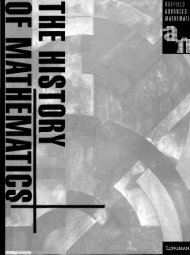Teachers' guide 2 - National STEM Centre
Teachers' guide 2 - National STEM Centre
Teachers' guide 2 - National STEM Centre
Create successful ePaper yourself
Turn your PDF publications into a flip-book with our unique Google optimized e-Paper software.
Apparatus, materials, and reagents<br />
The potentiometer wire is calibrated before use by noting the length of wire<br />
corresponding to a known e.m.f. from a standard cell. If a standard cell such as<br />
the Weston is not available, a mercury cell is a possible substitute. The Mallory<br />
RM-I or RM-1R is suitable for this.<br />
There are several ways in which suitable apparatus can be obtained.<br />
a Standard Physics apparatus can be bought, or borrowed from the<br />
Physics Department. For each potentiometer the following materials will be<br />
needed:<br />
2 keys for making and breaking the circuit<br />
1 straight wire potentiometer, 100 cm 3 , 0.050 cm -1 with jockey<br />
1 centre zero galvanometer (sensitivity at least 10 pA per division)<br />
1 protective resistance for galvanometer, approximately 10000<br />
1 2 V accumulator<br />
Leads<br />
Standard cell, Weston or mercury battery<br />
b Many of the components required for a straight wire potentiometer can<br />
be made quite cheaply.<br />
100 cm 3 Constantan wire (S.W.G. 28) can be mounted on a suitable length of<br />
wood together with a metre rule.<br />
A meter, switches and terminals can be mounted in a polythene box on the lid<br />
of which the circuit is clearly shown as in figure A.19.<br />
Figure A.19<br />
279

















